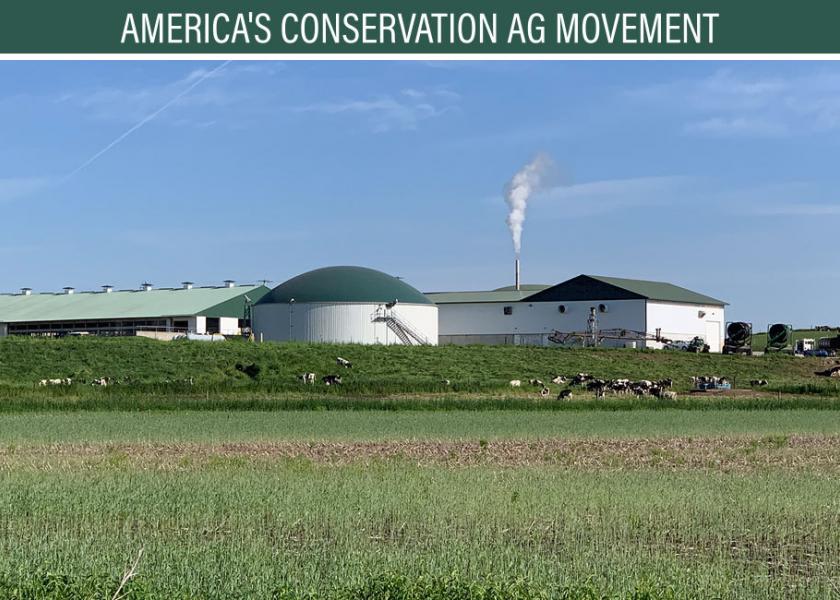A Cycle of Sustainability

Building trust in food begins with empowering farmers through one of the largest and most diverse conservation- and sustainability-focused public-private partnerships in our nation’s history: America’s Conservation Ag Movement. To find the latest news and resources related to the Movement, visit AgWeb.com/ACAM.
A focus on sustainability is not new for the Crave family of south-central Wisconsin. In fact, Mark Crave will tell you “what’s new in conservation was once old.” At Crave Brothers Farmstead Classics, a combination of new science and tried-and-true farming practices push the family toward their sustainability goals.
One of the new tools, that was “once old,” is their methane digester. The Craves installed the methane digester in 2006. Ten years later they found themselves at a crossroads — they could either invest in essential upgrades to the digester or
walk away.
“We decided we couldn’t just walk away from it because it is part of what we do,” Mark explains. “The manure system and our hot water system are tied into it. So, we actually went against convention and reinvested in the methane digester.”
When making the updates, the Crave family decided to install a bedding dryer as well. Today, the digester is critical to the farm as well as the surrounding community.
“Not only does it play a vital role on the farm, but it powers 300 homes in our community,” says George Crave.
The digester allows them to turn manure, whey from the creamery and wasted feed into power. What comes out the other end of the system is methane that can be turned into power, dry bedding and liquid manure that is stored in a concrete lagoon and then spread on their fields in accordance to their manure management plan.
To help customers understand the farm’s commitment to sustainability, the Craves have created a unique label for their farmstead cheese.
The digester is what Mark calls one spoke in the wheel of the family’s sustainability program. Cover crops, GMO seed and genomic testing also play a role in the farm's viability.
“It’s GMOs that allow us to use cover crops,” Mark explains. “Because now we can plant corn into a thick mat
of Italian ryegrass for example. We've had ryegrass in place all winter, and it’s doing the things you need to do: The soil is respirating, and we’re drying out excess moisture. We plant corn and then we come in with one pass and terminate that cover crop and have a corn crop coming up through it.”
Genomics allow the Craves to select which heifers to keep and breed back.
“We’re going to need fewer cows to produce the same amount of milk, and those cows are going to be healthier, requiring fewer treatments, with more productive days in their life,” Mark says.
As an industry, he adds, we haven’t done a very good job of helping others understand what sustainability is and how it works
“It’s the whole loop that we’re putting together; it’s not just one piece of the puzzle,” he says. “Dairy has led the way
to reduce our carbon footprint, and we just don’t talk about it enough.”
How the Craves’ Methane Digester System Works

The manure management system at Crave Brothers Farmstead Classics provides a multitude of benefits. Here’s how it works:
First, manure, whey and some pushout feed is added to the digester. “We run the manure as fresh as possible into the digester because, of course, that manure is decomposing all the time,” explains Mark Crave. “The sooner we get it into the digester, the more gas we’re going to capture.”
The Craves’ digester is a continuum mix digester, so it works similar to a cow’s rumen.
“You don’t want to change much very fast,” he says. “We’re always feeding it; we’re always taking manure out. Every day we put in what would be the volume of manure produced that day, and then that same amount of manure comes out.”
Then it goes through a screw press where 40% of the solids are separated. From there, the solids go through a drying system.
“In 2017, we installed a rotary drum dryer, and with it we change the moisture of fiber by about 10 to 15 percentage points,” he says.
Basically, the manure solids go from 70% moisture to 55% moisture, which makes it excellent material for bedding.
From there, the manure slurry is pumped into a concrete lagoon where it is stored until the Craves are able to spread it on their fields in accordance with their manure management plan.
“Because we’re a CAFO, we’re not able to spread manure until April 1 under Wisconsin law,” Mark explains.
That manure fertilizes the corn, which is fed to the cows at harvest. Then the cycle continues again.
Related Content:







